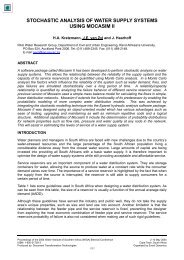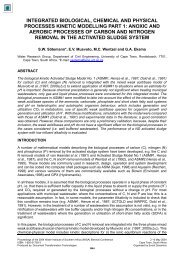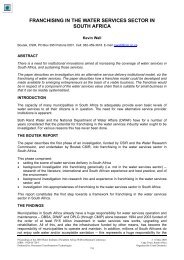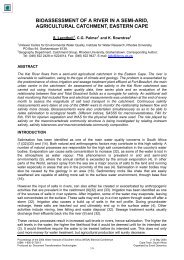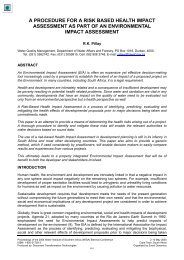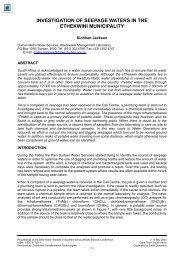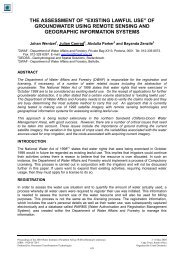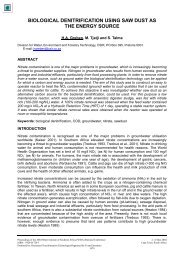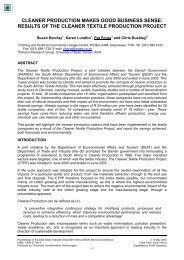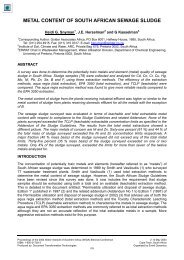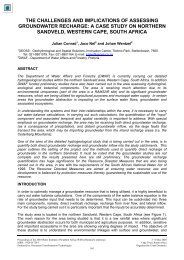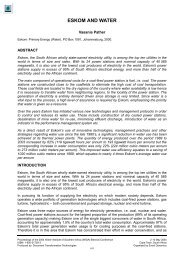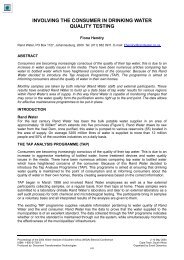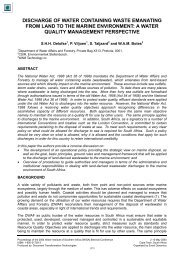eBook (pdf) - eWISA
eBook (pdf) - eWISA
eBook (pdf) - eWISA
You also want an ePaper? Increase the reach of your titles
YUMPU automatically turns print PDFs into web optimized ePapers that Google loves.
Hydrology<br />
The Berg River has its source in the<br />
Drakenstein and Franschhoek Mountains<br />
south of Franschhoek and discharges into<br />
the Atlantic Ocean near Velddrif, some 285<br />
km away. Major tributaries of the Berg River<br />
include the Franschhoek, Wemmershoek,<br />
Dwars, Kompagnies, Klein Berg, and<br />
Twenty-four Rivers. A striking characteristic<br />
of the catchment is the low density of<br />
drainage channels in the western parts of<br />
the catchment underlain by unconsolidated<br />
sandy recent deposits. Significantly higher<br />
drainage densities are observed in the<br />
central and eastern parts underlain by weathered and fractured rocks, mostly of the Malmesbury<br />
and Table Mountain Group. Two major dams have been built in the catchment. The<br />
Wemmershoek Dam south east of Paarl has a surface area of 3 km 2 and a storage capacity of 66<br />
million m 3 . The Voëlvlei Dam west of Tulbagh covers an area of 15 km 2 and has a storage<br />
capacity of 170 million m 3 . Numerous smaller farm dams are found throughout the east part of the<br />
catchment. Total natural runoff from the Berg River Catchment amounts to 931 million m 3 /a. These<br />
three catchments make up only 7% of the total area of the Berg River catchment. The estimated<br />
size of the catchment area of the Berg River Dam is about 70 km2, which is less than 0.8% of the<br />
total area of the Berg River Catchment. DWAF (1993) estimated present-day annual runoff of the<br />
Berg River amounted to 682 million m3/a, with the modified flow attributed to direct abstraction<br />
from the river for irrigation, storage and abstraction for urban water supply, development of<br />
forestry within the basin, irrigation return flow, and releases from the Voëlvlei, Wemmershoek and<br />
Theewaterskloof Dams (the latter via the Berg River Syphon).<br />
Flow and quality characteristics of the Berg River<br />
have been severely modified by abstraction from<br />
the river and the release of some 17 million m3/a<br />
of summer irrigation water from the<br />
Theewaterskloof Dam into the upper Berg River at<br />
the Berg River Syphon upstream of the proposed<br />
Berg River Dam site (1993 data; current releases<br />
amount to between 50 and 60 million m3/a). This<br />
water is used to supply irrigators downstream as<br />
far as Zonquasdrift. Downstream of Zonquasdrift,<br />
irrigation water is released from Voëlvlei Dam. It is<br />
of interest to note that in the geological past, the Berg River flowed from Assegaaibos past the<br />
position of the present tunnel siphon, straight past Robertsvlei camp and northeast down the<br />
Roberts River into the Franschhoek River. A mountain landslide resulted in blocking the upper<br />
reaches of the Robertsvlei gap, thereby causing the river to change its course to the present<br />
course through the proposed Berg River Dam site (Forbes, Dick and Associates 2001).<br />
The Berg River catchment falls within the winter rainfall region of the south-western Cape. Rainfall<br />
in the catchment increases from west to east.



